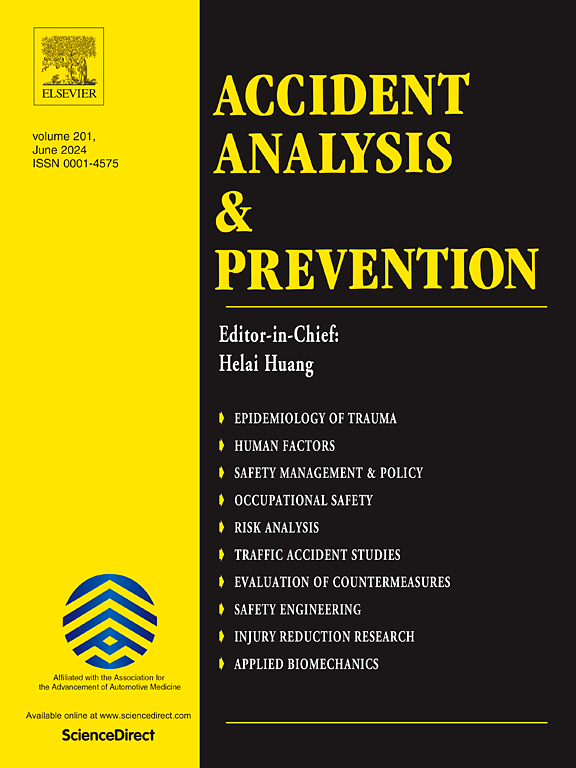运用路径分析方法探讨危险行为、原因因素与摩托车驾驶员损伤严重程度的相互关系
IF 5.7
1区 工程技术
Q1 ERGONOMICS
引用次数: 0
摘要
危险行为是造成摩托车手受伤严重程度的关键因素,在碰撞严重程度模型中,危险行为通常与其他因果因素并行处理。然而,道路使用者、道路和环境因素之间的相互作用可能会直接导致危险行为。因此,因果因素可能会通过危险行为间接影响摩托车手受伤的严重程度。本研究试图探讨因果因素对摩托车手受伤严重程度的直接、间接和总体影响,强调危险行为的中介作用。研究采用路径分析方法,对危险行为、其他因果因素和摩托车手受伤严重程度之间的复杂关系进行建模。具体来说,在路径分析框架内建立了两个模型,即一个随机参数 logit 模型,用于研究诱因与危险行为之间的关系;以及一个具有手段异质性的相关随机参数 logit 模型,用于评估这些因素与摩托车手受伤严重程度之间的相关性。利用密歇根州 2015 年至 2018 年的摩托车碰撞数据,研究发现,停止/让行标志、交叉路口、单向交通、双车道道路、午夜/清晨、周末和黎明/黄昏等因素并不直接影响摩托车手受伤严重程度,但会显著影响危险行为,从而通过这些行为间接增加受伤严重程度。此外,酗酒或吸毒、车速限制在 55 英里/小时或更高以及摩托车车龄在 6 年或以上都会显著增加危险行为的风险和摩托车手受伤的严重程度,从而通过危险行为的间接影响加剧受伤的严重程度。此外,带或不带交通护栏的分隔中间带、雨雪天气以及有路灯的黑夜都会直接降低受伤严重程度,但会通过危险行为间接增加受伤严重程度。这些发现强调了危险行为、其他致因因素和摩托车手受伤严重程度之间复杂的相互关系,为通过解决危险行为这一核心因素来提高摩托车安全提供了宝贵的见解。本文章由计算机程序翻译,如有差异,请以英文原文为准。
Exploring the inter-relationship among hazardous actions, causal factors, and motorcyclist injury severity using path analysis
Hazardous actions are the critical contributor to motorcyclist injury severity, which are typically treated in parallel with other causal factors in crash severity models. However, hazardous actions may result directly from the interaction between road users, roadway, and environmental factors. So, causal factors may indirectly influence motorcyclist injury severity through hazardous actions. The research attempts to investigate the direct, indirect, and total effects of causal factors on motorcyclist injury severity, emphasizing the role of hazardous actions as mediators. A path analysis approach is employed to model the complex relationship among hazardous actions, other causal factors, and motorcyclist injury severity. Specifically, two models are developed within the path analysis framework, namely, a random parameters logit model to examine the relationship between contributing factors and hazardous actions, and a correlated random parameters logit model with heterogeneity in means to assess the correlation between these factors and motorcyclist injury severity. Using motorcycle crash data in Michigan from 2015 to 2018, the study finds that factors such as stop/yield signs, intersections, one-way traffic, two-lane roads, midnight/early morning, weekends, and dawn/dusk do not directly affect motorcyclist injury severity but significantly influence hazardous actions, thereby indirectly increasing injury severity through these actions. Moreover, alcohol or drug use, speed limits of 55 mph or higher, and motorcycle age of six years or older significantly increase the risk of hazardous actions and motorcyclist injury severity, thus exacerbating injury severity through the indirect influence of hazardous actions. Additionally, divided median strips with or without traffic barriers, rain/snow weather, and darkness with streetlights directly reduce injury severity but indirectly increase it via hazardous actions. These findings underscore the complex inter-relationship among hazardous actions, other causal factors, and motorcyclist injury severity, offering valuable insights for enhancing motorcycle safety by addressing hazardous actions as a central factor.
求助全文
通过发布文献求助,成功后即可免费获取论文全文。
去求助
来源期刊

Accident; analysis and prevention
Multiple-
CiteScore
11.90
自引率
16.90%
发文量
264
审稿时长
48 days
期刊介绍:
Accident Analysis & Prevention provides wide coverage of the general areas relating to accidental injury and damage, including the pre-injury and immediate post-injury phases. Published papers deal with medical, legal, economic, educational, behavioral, theoretical or empirical aspects of transportation accidents, as well as with accidents at other sites. Selected topics within the scope of the Journal may include: studies of human, environmental and vehicular factors influencing the occurrence, type and severity of accidents and injury; the design, implementation and evaluation of countermeasures; biomechanics of impact and human tolerance limits to injury; modelling and statistical analysis of accident data; policy, planning and decision-making in safety.
 求助内容:
求助内容: 应助结果提醒方式:
应助结果提醒方式:


